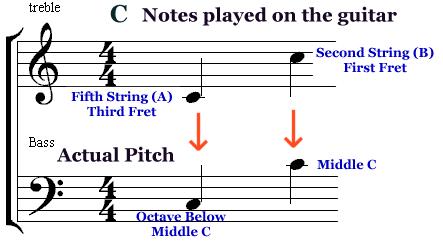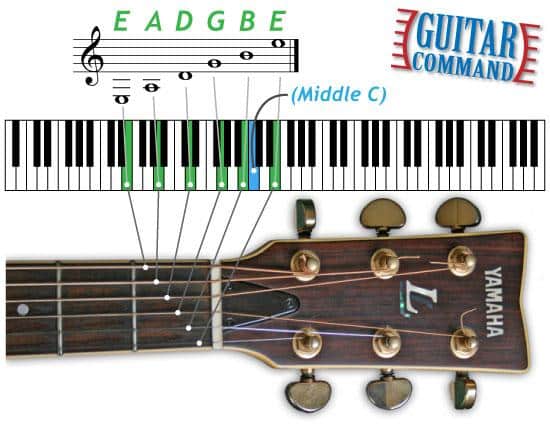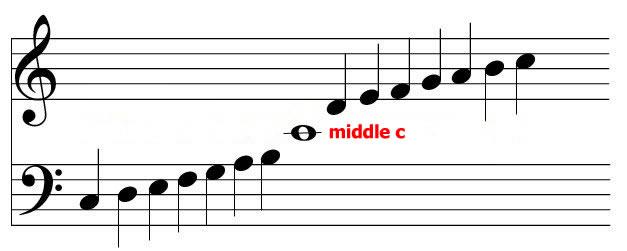Did you know there’s a secret gateway to unlocking music on your guitar? That’s right, a single note with the potential to open up the atomic structure of music to any guitarist – it’s the deceptively simple ‘Middle C’.
I remember the first time I discovered the powerful significance of Middle C on the guitar. It was as if a veil had been lifted, revealing the intricate patterns and relationships between notes that make up the tapestry of music.
In my years as a guitarist, an educator, and a devotee to the art of music, I’ve often found that understanding guitar theory, particularly the concept of Middle C, can be a game changer for beginners. This is an epiphany I’ve experienced personally and have seen mirrored in the faces of countless students when they’ve successfully located and played that note.
As an educator devoted to guitar theory, I’ve always enjoyed sharing about Middle C. It’s this brilliant cornerstone of theoretical understanding, a note that single-handedly helps budding guitarists step into a new realm of musical possibilities. However, its true significance and application on the guitar often goes overlooked.
It’s time to unveil the mystery and power of Middle C on the guitar. I invite you to step through that gateway with me, as we traverse the exciting landscape of guitar theory, navigating everything from locating Middle C in the standard tuning, to understanding transposing for the guitar. Read on to unveil beginner-friendly insights, backed by deep expertise and a love for educating.
What is Middle C on the Guitar?

Throughout my career as a guitar journalist and teacher, I’ve found that understanding concert pitch and the layout of notes, particularly Middle C, is a cornerstone in mastering the guitar. Guitarists often grapple with this elusive ‘middle C on guitar’, seemingly flustered by its multiple locations. Yet, Middle C, akin to the heart of the musical anatomy, is not just an abstract concept; it’s your anchor point, the pivot around which the entire fretboard’s spectrum of notes revolves.
So what exactly is Middle C on the guitar? It’s the specific pitch lying midway between the bass and the treble clef, universally recognized in the Western Music tradition. Emerging from the grand staff’s convergence point, Middle C serves as our musical North Star, aiding navigation across an assortment of instruments, including guitar. It is the singular note that retains the same name across all systems of notation, bridging gaps between different music reading methods.
But did you know that there’s more to the Middle C on guitar than meets the eye? While conventionally, middle C finds a home on the piano keyboard, its placement on the guitar is duplicable, allowing it to make appearances in multiple octave locations across the guitar strings and frets for Middle C.
This versatile characteristic changes the way you perceive your guitar. Instead of viewing it as a six-stringed puzzle, you begin to appreciate it as a map, allowing you to exploit the extended range of pitches uniquely presented by each string. Understanding Middle C takes us a step further in mastering this map, offering us a navigational vantage point.
The Middle C’s value, however, extends beyond its concert pitch on guitar. Every time you stumble upon Middle C, it offers a stark reminder of your guitar’s root-note omnipresence. It engrains within you the guitar’s fundamental layout, imparting a spatial understanding of your instrument’s fretboard.
This section, therefore, provides vital insight into the intertwined relationship of Middle C within the constellation of the guitar’s notes. It emphasizes the importance of Middle C’s understanding on the guitar, divulging its deeper significance beyond a mere note.
So as we traverse further in the later sections, we’ll learn the various locations of Middle C, its settings in standard tuning, its octave positions, and how it features in sheet music notation. By unraveling these complexities, we strive to achieve a holistic knowledge of our six-stringed companion. With Middle C as your compass, you’re all set to navigate towards your rendezvous with guitar mastery!
Where to Find Middle C on the Guitar
Middle C in Standard Tuning

I remember feeling a sense of wonder as a young guitarist, the day I understood the complexities of standard tuning. There’s something special about discovering how this standard tuning integrates Middle C on guitar. Let me share that knowledge.
Physically pinpointing Middle C on a guitar in standard tuning isn’t about looking at a chart or memorizing certain positions, but about understanding the underlying relationships and structures on your instrument. Standard tuning, often noted as EADGBE for the strings played from the heaviest to the lightest, has Middle C residing in various places.
In standard tuning, Middle C, also known as C4 in scientific pitch notation, is most commonly found on the A string of your guitar at the 3rd fret. However, it also exists in three other positions: the 10th fret on the D string, the 15th fret on the G string, and even the 20th fret on the B string. By connecting these positions, you gain further insight into the physical structure of the guitar’s fingerboard and comprehend the interaction of different octaves and keys.
Remember, understanding these placements isn’t just about memorizing positions; it’s about internalizing the rich complexity of your instrument. I recall the thrill of discovering these intricacies, of realizing how my fingers’ positions impacted the sound emanating from my instrument, and I yearn for you to experience the same.
As you advance in your understanding of Middle C on guitar in standard tuning, you’ll find these locations useful for transposing music and expanding into improvisation. The power of this note’s organization in standard tuning, with its symmetry and ease of access, enhances your ability to master the art of guitar playing. Never stop exploring.
In the next section, we’ll continue building on this understanding as we delve into the various octave positions of Middle C. Stay tuned!
Octave Positions of Middle C

Having an understanding of where the different octave positions of Middle C are located on the fretboard can open up vast possibilities on your guitar. As part of the discussion on where to find middle C on the guitar, it’s important to delve deeper into its octave positions.
In standard tuning, you can find Middle C in two primary octave positions. The first is on the 1st fret of the second (B) string; the second occurs on the 5th fret of the third (G) string. By learning these positions, you are laying the groundwork to navigate the guitar’s broader range confidently.
The significance of knowing the varied octave positions cannot be overstressed. Possessing this knowledge provides a new multi-dimensional perspective to the middle C on your guitar. This allows you to create more dynamic melodies and offers an expanded palette of tonal possibilities to explore.
Crucially, understanding these octave positions contributes to a more comprehensive comprehension of the guitar fretboard. It’s an indispensable component of developing your proficiency and fluency as a guitarist. I’m excited to help you unlock this potential, as it’s been an instrumental part of my own journey mastering this instrument.
As we proceed to discuss Middle C notation in sheet music, keep in mind the octave positions we’ve touched upon. Remember, a deeper understanding of Middle C will add depth to your musical repertoire, empowering your creative expression on the guitar.
Middle C Notation in Sheet Music

Having spent countless hours buried in piles of sheet music, meticulously transcribing and engraving, I’ve come face to face with the intricate language of music. This rich, symbolic script isn’t just a jumble of inky symbols on paper, but a conversation across time and culture. I’ve dedicated my life to becoming fluent in this very language, and my journey has always pivoted around Middle C – a point of true clarity. Exciting, isn’t it? Now, it’s high time you familiarize yourself with Middle C and its notations, for it will mill your skills in reading and notating guitar music.
Ever thought about why guitarists need to learn about Middle C notation in sheet music? Prepare to be enlightened! Guitar music notation is not the same as piano sheet music, so understanding the placement of notes on the ledger lines, and, indeed, the most crucial note, Middle C, is going to save you from hours of confusion. It’s essentially like finding your compass in the wilderness of sheet music.
Let me shed light on this. The Middle C is a note positioned at the borderline of the treble clef – the higher range of notes, and the bass clef – the lower range. This note serves as a reference point, it’s your landmark. Once you’ve determined where Middle C is located on your guitar and on your sheet music, everything else falls into place easily.
When you look at guitar sheet music reading, you’ll primarily see notes on the treble clef, but occasionally, there are notes dipping down into the ledger lines below, where Middle C and the bass clef notes reside. This is why understanding Middle C is imperative for guitarists. It’s the bridge between the two clefs, acting as a seamless pivot point for understanding the spatial relationship of all the other notes in relation to each other.
This might seem intimidating at first, especially given the number of strings and frets on a guitar. However, trust me when I tell you, once you’ve familiarized yourself with the feel and sounds of Middle C and its adjacent notes, it will become part of your instinct. It’s like learning to speak in a new accent. Initially, you have to focus on every word; eventually, it flows naturally.
Having personally transcribed and engraved countless pieces, I can’t stress enough how vital it is to understand Middle C. Once you’ve managed to interpret the lines, spaces, and dots that dance all over a piece of sheet music, you’ll find an indescribable joy in deciphering the rhythmic patterns and melodic sequences that tell a tale of their own.
So, as we dive deeper into the world of Middle C in the following sections, remember, learning to read music, and especially guitar sheet music, is like learning a new language. It might feel foreign at first, but eventually, it will start to make sense, opening up a whole new world of musical possibilities.
Understanding Transposing for the Guitar

Having tackled the varying aspects of Middle C within the realms of guitar theory, we can now venture onto an equally significant domain that can quite literally transform your playing experience – transposition. Before we delve into the ‘how’ aspect of the concept, one can’t help but ponder on a few essential questions.
Why is transposing crucial for a guitarist, and how does Middle C play into this? Let’s find out.
Building on my years of guitar mentorship and ceaseless performances, I’ve encountered the necessity to transpose numerous songs more times than I can count. It’s an intriguing blend of science and art, where the role of Middle C is much like the pivotal gear in a well-oiled machine.
When you’re dealing with a transposing instrument like the guitar, the process of transposition can be likened to changing the lens through which you see music. Suddenly, a complex melody in a challenging key becomes accessible in a preferential or comfortable key, amplifying both ease of playing and aesthetic pleasure.
Primarily, transposition involves shifting the pitch of each note in a piece by a certain interval, either to a higher octave or to a lower one. In essence, the soul of the song remains constant, but its tonal landscape changes. While the lyrics may echo familiar sentiments, the melody sings a subtly different tune, providing a fresher perspective to those strumming the strings and those riding the sound waves.
Middle C acts as a foundational pivot in this process. Knowing the many positions of Middle C and understanding its connection to other notes on your fretboard allows you to transpose with precision. For instance, if a song revolves around Middle C as its key note but poses technical difficulties or does not match your vocal range, you can use Middle C as your reference point and shift the piece to a key that suits you better. Transposing can turn into an easy, freeing exercise, seamlessly maintaining the relationship between notes and chords while altering the overall pitch.
Learning to leverage this knowledge is almost like acquiring a new language. And just like any new language, practice is key. So find a song you love, find its Middle C, and experiment with transposing it. You’ll soon find that the world of guitar music opens up to you in entirely new ways.
My journey with the guitar has been marked indelibly by countless transformations made possible through understanding transposition. And in sharing these insights with you, my hope is that your delivery of music becomes not just a methodical performance, but a heartfelt conversation enveloped in the beauty of varied tonal expressions. Because ultimately, that’s what truly understanding guitar theory provides — a fluidic, enchanting language to express the depths of human emotions.
FAQs
What is Middle C on the Guitar?
Why is Middle C important for beginners?
How do I locate Middle C on my guitar?
What is the role of Middle C in music notation?
Conclusion
So, how will the understanding of Middle C on the guitar benefit you in your musical journey? This comprehensive discussion has provided you with the essential basics of locating and recognizing middle C on the guitar, a fundamental step especially crucial in learning guitar for beginners.
Being able to decipher where middle C lies in standard tuning, across different octave positions, and understand its notation in sheet music, underlines the beginnings of guitar theory. The exploration also unearthed how an understanding of transposing specific to the guitar ties everything together. As you venture into the depths of guitar theory, these concepts will fall in place, rendering a more enriched understanding of how the strings, frets and scales intersect to form music.
As we close this guide, my hope is that your curiosity has been kindled by this initial exploration. The knowledge of middle C on the guitar was transformative in my own musical journey, providing a solid foundation from which I could grow and experiment, and it just might do the same for you.
Bearing in mind all the insights shared, continue practicing, never cease exploring further, and unlock your own unique relationship with the guitar. This is just the beginning of a long, rewarding journey that awaits you in the world of guitar playing; a journey enriched by understanding the fundamentals such as middle C, the backbone to many intricate music pieces.
